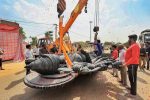
Deciphering the icy secrets of arctic’s permafrost methane
Team Udayavani, Jan 4, 2024, 9:08 AM IST

Almost a quarter of a century ago (on November 20, 1997), Indian Space Research Organisation (ISRO) had launched a Rohini RH-300 Mk-II sounding rocket from Ny-Alesund, a small town in Oscar II Land on Spitsbergen island in Svalbard, Norway. This solid fuel rocket was created by the Vikram Sarabhai Space Centre in Thiruvananthapuram. The rocket was transported from India to Norway for the mission and was rechristened ‘Isbjorn-I’ (Norwegian for ‘Polar Bear’) by the Norwegian Space Center
That was one of ISRO’s maiden Arctic-related ventures! However, the rocket did not achieve its intended altitude, reaching only 71 kilometres. It had been adapted for the Arctic climate; to keep the rocket at a stable temperature of 18° Celsius, scientists used a velostat shroud—a protective covering from a special material often used to shield electronics from static electricity and ensuring that a rocket’s components remain at a specific, controlled temperature, particularly in extreme environments such as in the Arctic
Isbjorn-I, unexpectedly, carried its velostat shroud with it during launch, which was not intended. This extra drag caused by the shroud was why the rocket could only reach its expected altitude. Despite this, Norwegian scientists were pleased with the launch. According to PV Manoranjan Rao and P Radhakrishnan, in their book, ‘A Brief History of Rocketry in ISRO’ (2012), the data gathered from the flight was valuable, offering new and insightful findings
In one of the Indian space agency’s most recent missions, the NASA-ISRO Synthetic Aperture Radar (NISAR) is set launch from Satish Dhawan Space Centre at Sriharikota aboard the ISRO Geosynchronous Satellite Launch Vehicle Mark-II in the first quarter of 2024 after a few tests, NASA officials have said. The ISRO-NASA collaboration project, NISAR, is a Low-Earth Orbit (LEO) observatory. The mission, of three years’ duration, aims to survey all of Earth’s land and ice-covered surfaces. NASA says the onboard instruments can spot a minor change of even one centimetre from space.
The entire globe will be mapped by NISAR every 12 days to provide “spatially and temporally consistent data” for understanding changes in Earth’s ice mass, besides its ecosystems, impacts of sea level rise worldwide and natural hazards—including volcanoes, tsunamis, earthquakes and landslides. It aims to understand, among other things, the dynamics of wetland and permafrost ecosystems and the response of ice sheets to climate change and the interaction of sea ice and climate.
*Methane Build-up in Permafrost*
In recent studies, scientists have now found a large amount of methane gas moving and increasing under the frozen soil of some Arctic Ocean islands. Svalbard—a remote group of Norwegian islands in the Arctic Circle, very close to the North Pole (only 800 kilometres away), and located far north of mainland Europe—is known for its rugged terrain, glaciers and polar bears, besides a unique and harsh environment with extreme cold and long, dark winters. A big amount of methane under Svalbard’s frozen ground could get out if the ice keeps melting due to climate change.
The study, published in ‘Frontiers in Earth Science’ on December 13, explains that the deep permafrost—ground that remains frozen for at least two years—in the Arctic has, so far, trapped a huge amount of methane gas. Permafrost acts as a strong cover, stopping the gas from escaping. However, it is uncertain if this will continue to hold the methane, a powerful greenhouse gas, and prevent it from releasing into the atmosphere in the future.
Powerful greenhouse gases—such as carbon dioxide, methane and nitrous oxide—absorb and emit radiant energy, significantly contributing to the greenhouse effect by trapping heat in Earth’s atmosphere and leading to the warming of the planet. The greenhouse warming effect is a major factor in climate change, affecting global temperatures, weather patterns and ecosystems. Methane, in particular, is known for its high heat-trapping ability, making it a potent greenhouse gas despite its lower concentration in the atmosphere compared to carbon dioxide.
*No Cause for Alarm—Just Yet!*
Permafrost covers a lot of Svalbard. When drilling into this frozen ground for fossil fuels, people often, by mistake, find natural gas—a type of fossil fuel, consisting mainly of methane (CH4) and other hydrocarbons. It is used as an energy source for heating, cooking and electricity generation. Natural gas is also used as a fuel for vehicles and as raw material in the manufacture of plastics and other commercially important organic chemicals. It is considered cleaner-burning than coal or oil, producing less CO2 when burned.
However, the size of these gas deposits was not known before this study. Thomas Birchall, a geologist at the University Center in Svalbard, Norway, however, stated to Space.Com that, currently, very little methane is leaking from beneath the permafrost in the region. But he did warn that melting glaciers and thawing permafrost in future might increase this leakage, releasing more methane gas into Earth’s atmosphere.
The bottom of the permafrost is not flat; it is uneven. This creates small spaces between the permafrost layer and the ground underneath. Gases from both living and non-living sources can build up and get stuck in these spaces. If the permafrost seal breaks, it could trigger a vicious cycle where the released methane would cause more permafrost to warm and melt, leading to release of even more methane and creating a self-reinforcing effect.
Birchall and his team dug out old records from business and research drilling holes to make a map of the permafrost in Svalbard and find where natural gas is located. The researchers discovered that methane-rich deposits are more widespread on the islands than previously believed. Since the group of islands shares geological and glacial history with the broader Arctic region, the statement suggests that similar methane-rich deposits may also be found in other areas covered in permafrost near the North Pole.
The study revealed that the permafrost layer in Svalbard varies and is not consistent throughout. Figuring out how much methane is under the permafrost is hard because it is tough to get to and there are only a few drilling holes to get information from. But, based on one place where they could measure the gas coming out, the researchers think there might be several million cubic feet of methane.
It noted that, in the coastal regions, the layer of frozen soil is thinner because of the heat from ocean currents. In contrast, the permafrost in lowland areas is thicker and full of ice, giving it excellent sealing qualities. This means it can ‘self-repair’. In higher elevation areas, the permafrost is more brittle and allows more substances to pass through it—a reason for drier conditions.
The study suggests that the current leak-proof permafrost in Svalbard may change. Svalbard is warming up very quickly compared to other places in the world. The top layer of permafrost, which thaws and freezes again every year, is getting thinner as the overall temperature of Earth increases. As the permafrost in the Arctic melts, there is a concern that releasing the methane trapped under it could cause a cycle of increasing climate change effects.
By Girish Linganna
(The author of this article is a Defence, Aerospace & Political Analyst based in Bengaluru. He is also Director of ADD Engineering Components, India, Pvt. Ltd, a subsidiary of ADD Engineering GmbH, Germany. You can reach him at: [email protected])
Udayavani is now on Telegram. Click here to join our channel and stay updated with the latest news.
Top News
Related Articles More

Reservation row: Congress campaign ‘biggest lie’ of the decade, says Kishan Reddy

BJP trying religious polarisation in Nagaon: Congress candidate Pradyut Bordoloi

3 arrested for ATM manipulation in Delhi

Heroin worth Rs 600 crore seized from Pakistani boat off Gujarat coast; 14 held

Congress accuses Modi Government of undermining reservations through privatization
MUST WATCH
Latest Additions

Some countries, institutions want weak govt to make easy profits: PM Modi

People can talk anything they want to, I know my game better: Virat Kohli on his strike rate

Sexual harassment, stalking case registered against ex-minister H D Revanna and his son Prajwal

Reservation row: Congress campaign ‘biggest lie’ of the decade, says Kishan Reddy

BJP trying religious polarisation in Nagaon: Congress candidate Pradyut Bordoloi

























